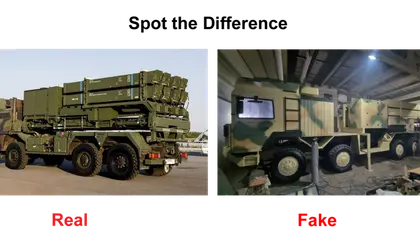An alleged Russian strike by an Iskander ballistic missile on a Ukraine air defense missile site that was applauded by Russian milbloggers on Wednesday was actually a decoy placed on the site of a previously destroyed S-300, according to Ukrainian military commentator video posts.
The Russian website LostArmour compiles open-source information on (only Ukrainian) military losses during President Putin’s “special military operation.” On Wednesday it published a video that it said showed a strike on an IRIS-T air defense missile system, which it says was geolocated to the village of Lisne in the Kharkiv region.
JOIN US ON TELEGRAM
Follow our coverage of the war on the @Kyivpost_official.
The video was re-posted by several more Russian milbloggers, including the bmpd Telegram channel, who crowed that “lightning does strike in the same place twice” as they claimed this was the same location in which a Ukrainian S-300 air defense system had been previously destroyed.
The claims were quickly picked up by Ukrainian bloggers who said, in the sarcastic phrase they frequently use when disproving Russian narratives: “there is a nuance.” Posts on the Insider UA Telegram channel and by the Ukrainian X (formerly Twitter) user Cloooud showed that the site was actually an intricate decoy.
According to open-source information the site had indeed been a former Ukrainian Armed Forces (AFU) air defense site but it had been abandoned and, in its place the decoy replica IRIS-T components were installed.

Putin Proposes ‘Duel’ Between Oreshnik and Western Air Defense Over Kyiv
As Kyiv Post reported last September Ukraine, led by the Metinvest steel company, has been producing advanced fake replicas of advanced weapon systems using a wide range of scrap materials that have fooled Russian operators into expending artillery, drones and missiles to destroy them.
The main shareholder of Metinvest, which previously ran the Azovstal steelworks in Mariupol, is billionaire Rinat Akhmetov, who has approved and provided much of the funding for the decoy project, according to a company spokesperson.
Wednesday’s incident suggests that money has been well-spent. It is estimated that the IRIS-T decoy, which included a motorized revolving “radar detector,” cost around $10,000 while the Russian Iskander missile that struck it was valued, in a Ukrainska Pravda article in December, at $3 million.
Apart from the monetary comparison the better calculation is that this has removed another key Russian asset from the battlefield and potentially saved a critical Ukrainian air defense system.
You can also highlight the text and press Ctrl + Enter






